Cork IELTS Reading Answers
5 min read
Updated On
-
Copy link

Limited-Time Offer : Access a FREE 10-Day IELTS Study Plan!
The Academic passage ‘Cork’ is a reading passage that appeared in an IELTS Test.
Ideally, you should not spend more than 20 minutes on a passage. Let’s see how easy this passage is for you and if you’re able to make it in 20 minutes. If not, try more IELTS reading practice tests from IELTSMaterial.com
Cork
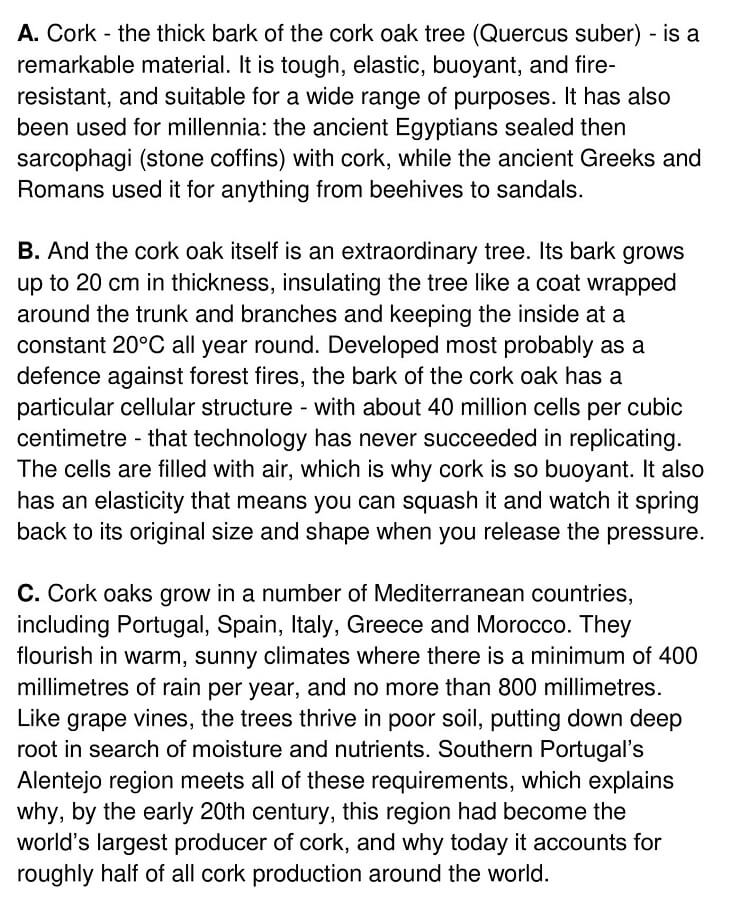
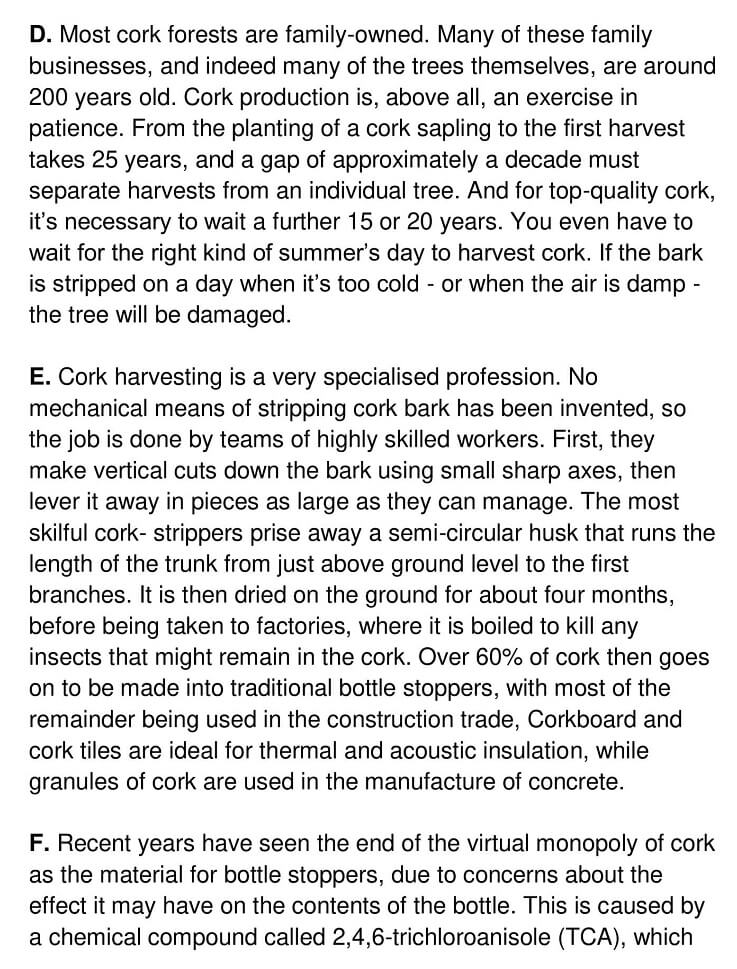
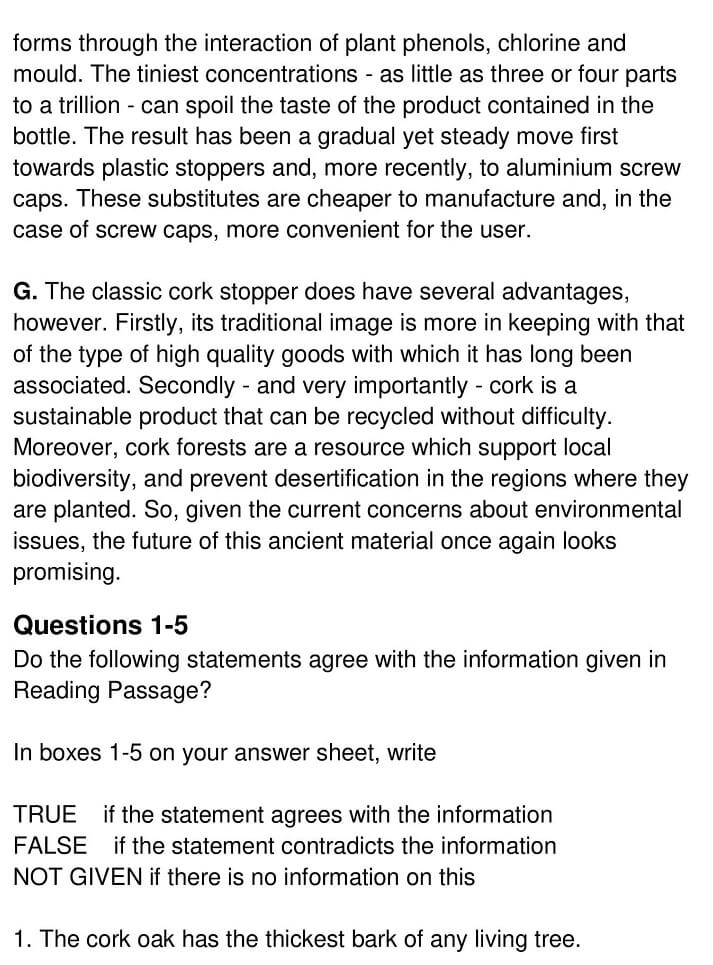
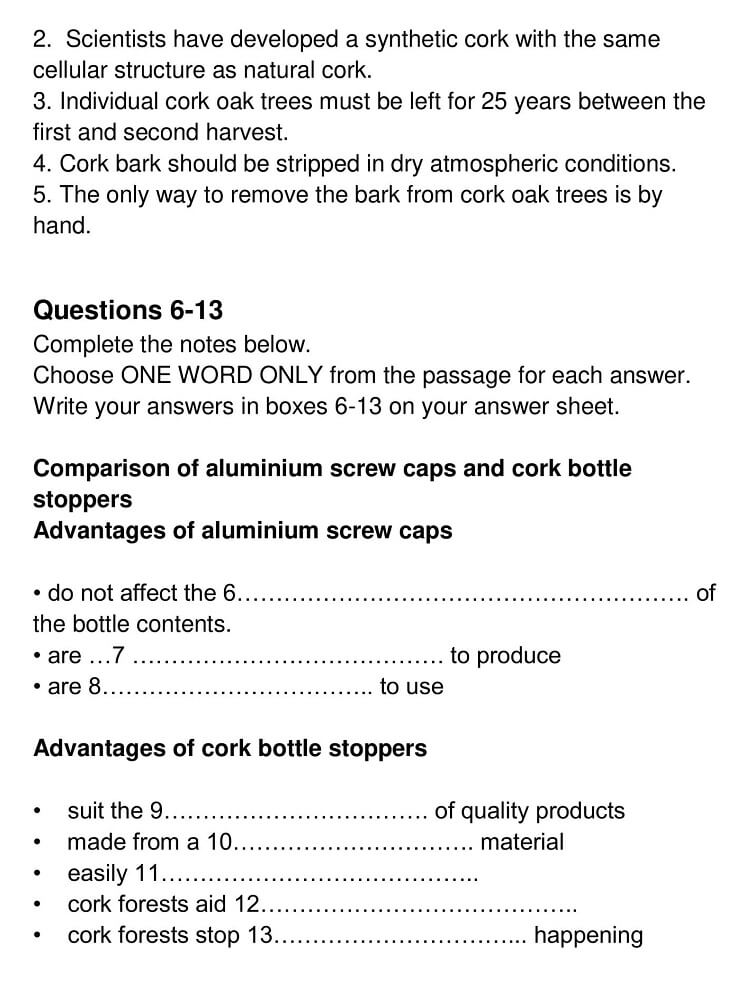
Answers
| Question number | Answer | Keywords |
|---|---|---|
| 1 | NOT GIVEN | In paragraph A, it is mentioned that Cork, the ‘thick bark of the cork oak tree’ (Quercus suber), is a remarkable material. In paragraph B, it is said the cork oak itself is an extraordinary tree. Its bark ‘grows up to 20 cm in thickness’. The writer says that it is thick, but there is no mention of it being the ‘thickest’ or there is no comparison with other trees. Hence, the answer is ‘NOT GIVEN’. |
| 2 | FALSE | Paragraph B brings out the fact that the bark of the ‘cork oak’, developed most probably as a defence against forest fires, ‘has a particular cellular structure’ – with about 40 million cells per cubic centimetre – that technology has ‘never succeeded in replicating’. As the statement contradicts the information, the answer is ‘FALSE’ |
| 3 | FALSE | In paragraph D, it is said that from the planting of a cork sapling to the ‘first harvest takes 25 years’, and a ‘gap of approximately a decade’ (decade is equal to 10 years) must separate harvests from an individual tree’. And for top-quality cork, it’s ‘necessary to wait a further 15 or 20 years’. Therefore, a gap of 10 years (not 25 years) must be given between the first and second harvest for individual trees. As the statement contradicts the information, the answer is ‘FALSE’ |
Unlock Answers
| 4 | TRUE | Paragraph D states that you even have to wait for the right kind of ‘summer’s day to harvest’ cork. If the bark is stripped on a day when ‘it’s too cold – or when the air is damp’ (dry atmospheric condition) – the tree will be damaged. As the statement agrees with the information, the answer is ‘TRUE’. |
| 5 | TRUE | Paragraph E informs that no mechanical means of stripping cork bark has been invented (means it is done by hand), so the job is ‘done by teams of highly skilled workers’. As the statement agrees with the information, the answer is ‘TRUE’. |
| 6 | taste | Paragraph F points out that recent years have seen the ‘end of the virtual monopoly of cork as the material for bottle stoppers’, due to concerns about the ‘effect it may have on the contents of the bottle’.The ‘tiniest concentrations’ (of TCA) – as little as three or four parts to a trillion – can ‘spoil the taste of the product’ contained in the bottle. The ‘result has been a gradual yet steady move’ first towards plastic stoppers and, ‘more recently, to aluminium screw caps’. Hence, the answer is ‘taste’. |
| 7 | cheaper | Paragraph F provides the fact that the result has been a gradual yet steady ‘move recently, to aluminium screw caps’. These ‘substitutes’ (the aluminium screw caps) ‘are cheaper to manufacture’ and, in the case of screw caps, more convenient for the user.
Hence, the answer is ‘cheaper’. |
| 8 | convenient | Paragraph F tells that the result has been a gradual yet steady ‘move recently, to aluminium screw caps’. ‘These substitutes’ are cheaper to manufacture and, in the case of screw caps, ‘more convenient for the user’. Hence, the answer is ‘convenient’. |
| 9 | image | Paragraph G mentions that the classic cork stopper does have several advantages, however. Firstly, ‘its traditional image’ is more in keeping with that of the type of high quality goods with which it has long been associated. Hence, the answer is ‘image’. |
| 10 | sustainable | Paragraph G states the second and very important advantage of cork – ‘cork’ is a ‘sustainable product’ that can be recycled without difficulty. Hence, the answer is ‘sustainable’. |
| 11 | recycled | Paragraph G points out the second and very important advantage of cork – ‘cork’ is a sustainable product that ‘can be recycled’ without difficulty. Hence, the answer is ‘recycled’. |
| 12 | biodiversity | From paragraph G, it is found out that ‘cork forests’ are a resource which ‘support local biodiversity’, and prevent desertification in the regions where they are planted. Hence, the answer is ‘biodiversity’. |
| 13 | desertification | In paragraph G, the writer writes ‘cork forests’ are a resource which support local biodiversity, and ‘prevent desertification’ in the regions where they are planted. Hence, the answer is ‘desertification’. |
Check More IELTS Reading Answers
Also check :
Practice IELTS Reading based on question types

Start Preparing for IELTS: Get Your 10-Day Study Plan Today!
Recent Articles

Nehasri Ravishenbagam

Haniya Yashfeen

Haniya Yashfeen

Haniya Yashfeen
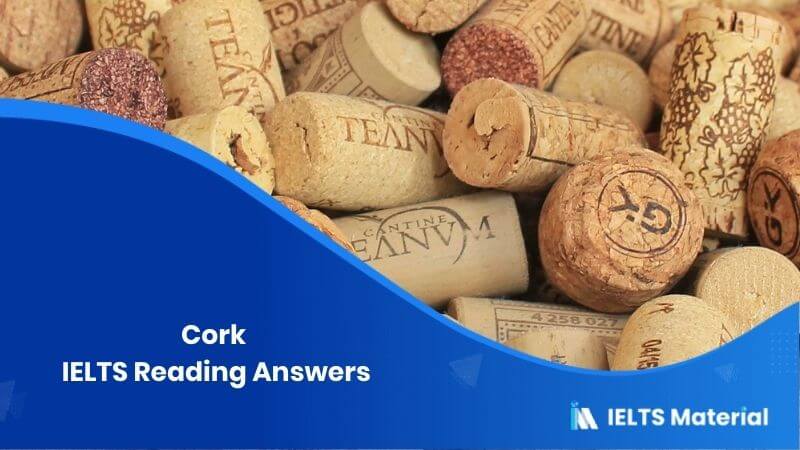



Post your Comments